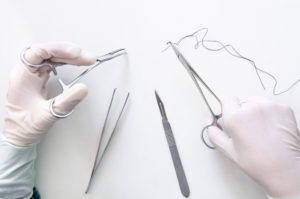 When Mohs surgery is performed to remove skin cancer, the last step of the procedure is typically closing the wound with a suture. This can be accomplished using different techniques, such as a side-to-side linear closure or a skin flap, but regardless of the reconstructive approach, the surgical site is usually closed in two layers of stitches. “A deep layer of stitches is used under the skin to guide the healing process, and a top layer of sutures is used to close the skin,” says fellowship-trained Mohs micrographic surgeon Dr. Adam Mamelak.
When Mohs surgery is performed to remove skin cancer, the last step of the procedure is typically closing the wound with a suture. This can be accomplished using different techniques, such as a side-to-side linear closure or a skin flap, but regardless of the reconstructive approach, the surgical site is usually closed in two layers of stitches. “A deep layer of stitches is used under the skin to guide the healing process, and a top layer of sutures is used to close the skin,” says fellowship-trained Mohs micrographic surgeon Dr. Adam Mamelak.
As surgical materials have continued to advance, a variety of sutures are available based on the details of the case. Non-absorbable sutures may be used, which will need to be removed later. Others are absorbable, which means the body will naturally break them down over the course of about 3 to 4 months. These absorbable stitches are ideal for closing the deeper layer of tissue after Mohs surgery. However, keep in mind that although they dissolve, absorbable sutures are still a foreign object that the body may reject.
What Is a Spitting Suture?
In some cases an absorbable suture can be “spit out” if the body doesn’t break it down. This happens when the stitch is gradually pushed out of the skin because the body is rejecting the material. Spitting sutures can feel like a sharp spot on the incision, and a small white thread may start emerging. Other times, a spitting suture can simply look a pimple or red bump near the wound. While this can happen with some patients after Mohs surgery, there are ways to reduce the risk of a spitting suture.
Dr. Mamelak utilizes specific suture types that tend to cause fewer adverse reactions. He also checks the size and depth of the suture to make sure any non-absorbable sutures are taken out when appropriate. In addition, there are some cases that don’t require the use of a suture at all, which completely avoids the chance of the body spitting it out.
What to Do if a Spitting Suture Happens?
Spitting sutures can usually be treated very easily. A warm, moist compress can be applied to the raised area to help expose more of the suture. Once this is accomplished, your doctor can trim the material.
If have any questions about Mohs surgery, or if you are struggling with a spitting suture or other post-operative concern, please contact The Austin Mohs Surgery Center.
